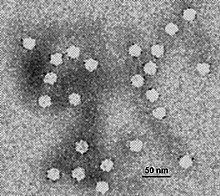| Carnivore protoparvovirus 1 | |
|---|---|

| |
| Electron micrograph of canine parvovirus | |
| Virus classification | |
| (unranked): | Virus |
| Realm: | Monodnaviria |
| Kingdom: | Shotokuvirae |
| Phylum: | Cossaviricota |
| Class: | Quintoviricetes |
| Order: | Piccovirales |
| Family: | Parvoviridae |
| Genus: | Protoparvovirus |
| Species: | Carnivore protoparvovirus 1
|
| Member virus[1] | |
| |
Carnivore protoparvovirus 1 is a species of parvovirus that infects carnivorans. It causes a highly contagious disease in both dogs and cats separately. The disease is generally divided into two major genogroups: FPV containing the classical feline panleukopenia virus (FPLV), and CPV-2 containing the canine parvovirus type 2 (CPV-2) which appeared in the 1970s.[2]
Belonging to the family Parvoviridae, FPLV have linear, single-stranded DNA (ssDNA) genomes. This agent is one of the smallest animal viruses, barely 18 to 20 nm in diameter.[3] Like other parvovirus genomes, it has hairpin structures at both ends of its genome: 3-genome Y-type structure and 5-terminal U-shaped structure, making it challenging to amplify the full-length genome of parvovirus despite its small size.[4] Sequences in the genome show a high degree of nucleotide conservation in the VP2 gene after over 90 years since it has emerged; the VP2 gene codes for the capsid protein VP2, a main structural protein, which determines the major mutations during the evolution of CPV.[5]
FPLV is known to infect all wild and domestic members of the felid (cat) family worldwide.[6] It is a highly contagious, severe infection that causes gastrointestinal, immune system, and nervous system disease. Its primary effect is to decrease the number of white blood cells, causing the disease known as feline panleukopenia.
Although it was once thought that only FPLV caused panleukopenia in cats,[7] it has been confirmed that a feline panleukopenia illness can be caused by CPV 2a, 2b, and 2c.[8][9]
FPLV is commonly referred to as:
- feline infectious enteritis virus (FIE)[6]
- feline parvovirus (FPV or FP or "feline parvo")[10]
- feline parvoviral enteritis[6]
It is sometimes confusingly referred to as "cat plague" and "feline distemper".[11]
In addition to members of the felid family, it can also affect other carnivorans (e.g. raccoon, mink).[6]
- ^ "Genus: Protoparvovirus". International Committee on Taxonomy of Viruses (ICTV). Retrieved January 8, 2019.
Member species Species Virus name(s) Carnivore protoparvovirus 1 canine parvovirus CPV
[dead link] - ^ Mira F, Canuti M, Purpari G, Cannella V, Di Bella S, Occhiogrosso L, Schirò G, Chiaramonte G, Barreca S, Pisano P, Lastra A, Decaro N, Guercio A (March 2019). "Molecular Characterization and Evolutionary Analyses of Carnivore Protoparvovirus 1 NS1 Gene". Viruses. 11 (4): 308. doi:10.3390/v11040308. PMC 6520740. PMID 30934948.
- ^ Evermann JF, Kennedy MA (January 2011). "Chapter 16 - Viral Infections". In Peterson ME, Kutzler MA (eds.). Small Animal Pediatrics. Saint Louis: W. B. Saunders. pp. 119–129. doi:10.1016/B978-1-4160-4889-3.00016-4. ISBN 978-1-4160-4889-3. S2CID 78254034.
- ^ Leal É, Liang R, Liu Q, Villanova F, Shi L, Liang L, Li J, Witkin SS, Cui S (January 16, 2020). "Regional adaptations and parallel mutations in Feline panleukopenia virus strains from China revealed by nearly-full length genome analysis". PLOS ONE. 15 (1): e0227705. Bibcode:2020PLoSO..1527705L. doi:10.1371/journal.pone.0227705. PMC 6964837. PMID 31945103.
- ^ Miranda C, Vieira MJ, Silva E, Carvalheira J, Parrish CR, Thompson G (August 2017). "Genetic Analysis of Feline Panleukopenia Virus Full-length VP2 Gene in Domestic Cats Between 2006-2008 and 2012-2014, Portugal". Transboundary and Emerging Diseases. 64 (4): 1178–1183. doi:10.1111/tbed.12483. PMID 26924760. S2CID 26070126.
- ^ a b c d "Overview of Feline Panleukopenia - Generalized Conditions". Merck Veterinary Manual. Retrieved March 9, 2019.
- ^ "ICTV Taxonomy history: Carnivore protoparvovirus 1". International Committee on Taxonomy of Viruses (ICTV). Retrieved January 8, 2019.
- ^ Marks SL (2016). "Rational Approach to Diagnosing and Managing Infectious Causes of Diarrhea in Kittens". August's Consultations in Feline Internal Medicine, Volume 7. pp. 1–22. doi:10.1016/B978-0-323-22652-3.00001-3. ISBN 978-0-323-22652-3. S2CID 78691815.
- ^ Ikeda Y, Nakamura K, Miyazawa T, Takahashi E, Mochizuki M (April 2002). "Feline host range of canine parvovirus: Recent emergence of new antigenic types in cats". Emerging Infectious Diseases. 8 (4): 341–346. doi:10.3201/eid0804.010228. PMC 2730235. PMID 11971764.
- ^ "Feline panleukopenia". AVMA.org. American Veterinary Medical Association.
- ^ Sykes JE (2014). "Feline Panleukopenia Virus Infection and Other Viral Enteritides". Canine and Feline Infectious Diseases. pp. 187–194. doi:10.1016/B978-1-4377-0795-3.00019-3. ISBN 978-1-4377-0795-3. S2CID 89381646.